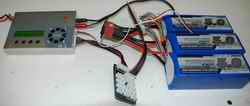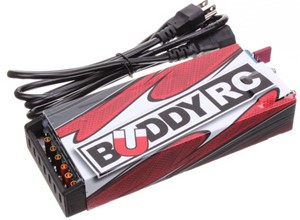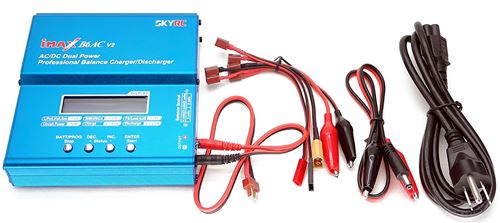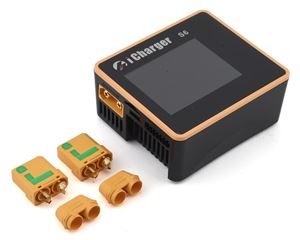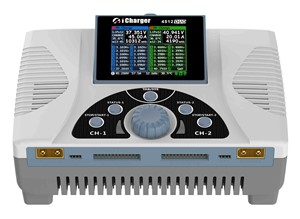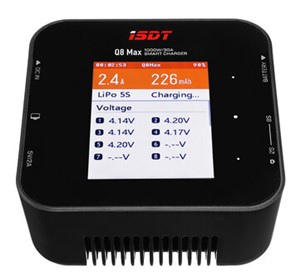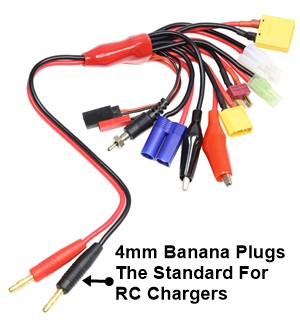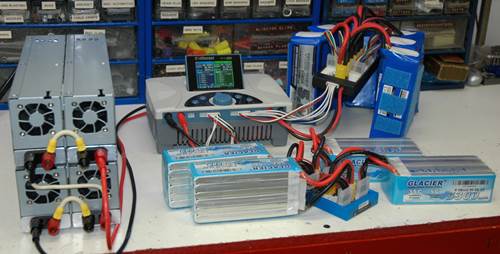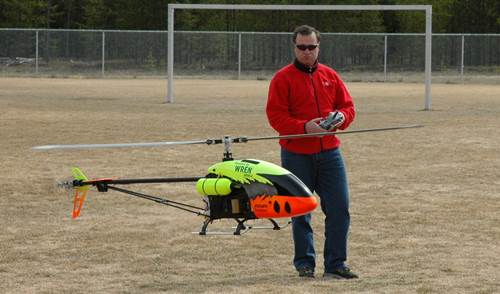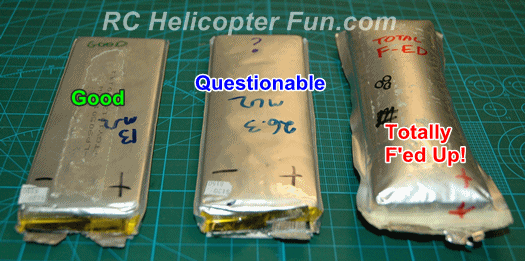How to Choose The Best RC Battery Charger For You
by John Salt - Updated April 2025
I'm often asked what's the best RC Battery Charger. Like most items in this hobby, there is no "Best". Budget, features, and charging power all come into play.
No question, an RC battery charger is one of the single most important items you'll need to purchase when getting into electric flight, or any electric powered RC vehicle for that matter. LiPo batteries have after all revolutionized our hobby.
LiPo RC battery chargers are also one of the most misunderstood items in the hobby and most people just get what the advertisement or sales person recommends without doing a little number research first.
This generally leads to getting an inadequate RC charger for your needs; either overpowered, but in most cases under-powered or without some very important features.
I will also be covering how you power your charger because I get so many questions on that single topic alone and once again, there are many misconceptions.
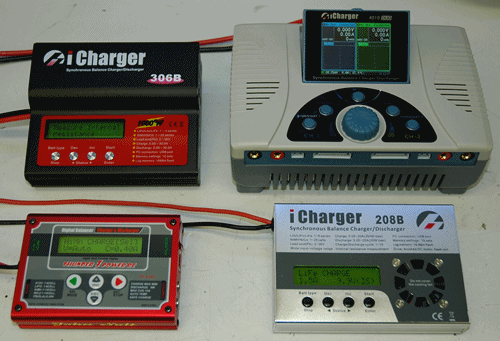 Computerized RC Battery Chargers Will Charge All Battery Types. LiPo, NiMh, NiCad, Li-Ion, Li-Fe, & PB.
Computerized RC Battery Chargers Will Charge All Battery Types. LiPo, NiMh, NiCad, Li-Ion, Li-Fe, & PB.Since LiPo and various forms of lithium chemistry such as LiFe, and lithium ion, are so popular these days, good lithium battery charging & balancing support is what makes or breaks a computerized RC battery charger.
Best RC Battery Charger - Computerized or Smart?
All smart chargers are computerized chargers, but not all computerized chargers are smart chargers - What?
Recent marketeering has started calling computerized RC battery chargers "smart chargers."
I have no idea where, why, or how this misnomer started, but it's factual nonsense; at least if you accept the industry standard definition of a smart device.
"A smart device is defined as a microprocessor controlled electronic device, connected to other such devices or networks via different protocols such as Wi-Fi, Bluetooh, 3,4,5G, etc."
So, I'll be sticking with the term "computerized charger" throughout this article. There are by the way BattGo, Bump & Spektrum true Smart chargers, which I'll talk about shortly - I'm not a fan.
With that said, modern day computerized RC chargers certainly could be considered smart in that they have small microprocessors running sophisticated charging & discharging algorithms with voltage, current, and temperature sensing to provide automatic, efficient, and safe usage and improved battery health.
In this day and age with all the good computerized RC battery chargers
on the market, the only chargers that I am going to talk about and
recommend support all rechargeable battery types (NiCad, NIMH, PB, and
of course lithium); the reason being, one charger will support all your
charging needs.
Myself, I'm an iCharger guy...
iCharger in my opinion offer the best bang and quality for your charging buck. I've been using their various chargers for over 15 years now and have been very happy with the long term performance. That's something I can't say for most other brands.
Why Get A Computerized RC Battery Charger?
Getting a quality computerized battery charger should be seen as an investment for your long term enjoyment of this hobby, most certainly if you are into electric powered flight. Computerized chargers have all sorts of benefits, but there are three that stand out in my opinion:
1. Unmatched Versatility
A computerized battery charger can be used to charge and maintain all your batteries regardless of chemistry make up, size, capacity, or voltage. From large flight batteries, to transmitter batteries, to your flight box battery.
You can even charge you car battery if you wanted to. They are so versatile you will honestly wonder how you ever lived without a good computerized charger once you get one and chances are you will end up charging much more than just your RC batteries with it.
2. Safety & Accuracy
A good computerized battery charger pays for itself many times over by ensuring your batteries are safely and accurately recharged every time.
This will give you the best life possible out of your batteries and in some cases; you can even bring older batteries back to life with features such as cycling, forming, and of course balancing.
With the amount of money some of us have invested in battery packs for our birds, a good RC battery charger/s is one of the most important RC support items we can purchase that can literally save hundreds if not thousands of dollars in battery damage.
3. Confirmation of Battery Capacity & Overall Health
Perhaps the feature I like best with computerized RC battery chargers is they accurately tell me my battery condition by showing how much charge goes into them.
This saves aircraft and ensures an 80% discharged 5000 mAh rated battery for example, is in fact taking all that 80% (4000 mAh) of capacity during a charge cycle.
Think of it like filling up the gas tank in your vehicle without being able to see how many gallons of gas was going into the tank from the read-out on the pump, and you didn’t have a fuel gauge. Pretty difficult to know how long it would be before you run out of gas if that was the case right?
Being able to “see” how much charge goes into your batteries offers the same benefit as seeing how much gas goes into your tank.
The Video below shows me charging the wife's vehicle battery with one of my iChargers. Computerized RC battery chargers like this offer great value for many charging applications beyond that of RC.
How To Use A Computerized Battery Charger
A short video I made below showing the basics of how to use a typical RC battery charger to charge a LiPo battery.
Power Requirements & Cell Counts
The first item to consider when looking for your best RC battery charger is how much power it can deliver and maximum cell count it will support.
Cell count is pretty easy to figure out, and most good computerized RC battery chargers support at least 6S LiPo cell counts and up to 15 or more NiCad, NIMH celled packs. The confusion for most comes into play with the maximum charge current.
This is where many people select the wrong charger for their actual needs. From my LiPo battery write up , you have a good understanding of the amount of charge current measured in Amps that your specific battery can handle. You must understand that before you can determine what size charger you need; so if you haven’t read my LiPo page, or it is still a little foggy, have another look.
Let’s take a popular size LiPo used in a 500 size/class helicopter for example such as a 3000 mAh 6S (22.5V) pack. At a 1C charge rate, the charge current for this battery would be 3.0 Amps. A 2C charge rate (getting to be very normal these days) would be 6.0 Amps.
So when you go out to get your RC Battery charger, your thought is to get one with at least a 6 Amp charge rate – right? Well, there is another very important specification on RC battery chargers that you must also look at, and that is the wattage output rating (measured in Watts).
The problem is many RC battery charger manufacturers just boast of the maximum charge current & voltage or cell count.
Without the wattage rating, you may be in for a big surprise the first time you go to charge your battery and select a high current charge rate only to find out that the charger won’t deliver it.
Why? Wattage!
Watts are calculated by multiplying the voltage by the Amps.
So our 3000 mAh 6S LiPo battery when it's near a full charge voltage of 25.2 volts while being charged at 3 Amps, will be drawing about 76 watts of power (25.2 volts x 3.0 Amps).
If we charged it at a 2C rate, that wattage number would increase to around 150 Watts (25.2 x 6.0) and so on.
This doesn’t take into account any efficiency losses in the charger or the input voltage to the charger which also both play a roll. However, for ease of explanation, let’s just say if that’s the largest battery you will ever charge at nothing higher than a 2C charge rate, you need to get a charger rated not only at a 6 Amp charge rate, but also a 150 Watt or higher power rating.
If the charger is only rated at 80 Watts for example, but boasts a 10 Amp charge rate, it would still be able to only deliver about 3 Amps when a 6 cell LiPo is nearing it’s full charge voltage of 25.2 volts (80W divided by 25.2 volts = 3.17 Amps).
Even though the charger is rated at a maximum 10 Amp charge rate, it would only be able to deliver 3 Amps at 25.2 volts and that is not taking into account any efficiency losses.
So why can the charger manufacturer in this example claim a maximum charge rate of 10 Amps?
Well, depending on the voltage of the battery you are charging, a 10 Amp charge rate is possible. If you were charging a two cell LiPo pack for example (8.4 volts fully charged) on this 80 Watt charger, at that voltage it will be able to deliver almost 10 Amps (80W divided by 8.4 volts = 9.5 Amps).
The manufacturer is certainly not lying about the maximum charge rate, but if they don’t include the wattage rating of the charger along with that number, you are only getting half the story!
With more advanced charging methods such as multiple pack parallel charging being very popular, even if you never got into larger models that required higher voltage/capacity battery packs, even an 80 Watt charger would be somewhat limiting.
The good news is some of these very high wattage RC battery
chargers don’t really cost that much more than lower powered ones.
If you intend on getting into 500 size and larger birds down the road and want to charge at higher C rates or want to charge multiple packs in parallel to save time, you really have to start looking at more powerful chargers in the 200 to 400 Watt range. For instance, a typical 550 size electric RC helicopter uses a 5000 mAh 6S battery pack.
At a 2C charge rate, the charger would have to not only support
both a 6 cell count (25.2 volts) and a 10 Amp charge rate, but would have to be rated
at a bare minimum of 250 Watts (10 Amps x 25.2 volts).
RC Charger Balance Current - Moderately Important.
Another fairly important specification to look at when choosing your best RC charger is the maximum rated balance discharge or drain current.
Higher end RC chargers balance multi celled (2S & higher) LiPo, LiHV LiFe, & Lilo batteries by putting a resistive load on each individual cell through the balance plug, while charging the battery through the main discharge/power connector.
This "passive balancing" which is covered in detail on the LiPo Battery Balancing page, ensures none of the cells in the battery pack are going over the fully charged cut off voltage during a charge cycle (usually 4.2V in a LiPo battery).
The higher this balance discharge current is, the faster the battery will finish the final bit of charging (when most cell balancing actually occurs).
There are certainly other factors that dictate how long the last little bit balancing takes such as capacity of the pack/s and how far the cells within the pack/s are out of balance caused by internal resistance difference between cells; but balance current drain plays a part.
If for example you have a powerful charger that charges up your healthy packs at the full charge current during the first part of the charge, but then when they get to about a 95% charged state, charging slows right down and then takes almost as long to get that last 5% as it did for the entire charge cycle. A likely cause is your charger has a very low balance discharge current.
I generally like to see a 1.0A (1000mA) or higher balance drain current when looking for the best RC battery charger for my needs. You won't find many (if any) RC chargers that go over a 3A balance drain current however because you are reaching the maximum current handling capacity of the balance plug and wiring.
So take a look at the manual or specifications of any RC charger you are considering as shown below with an iCharger S6 example (red arrow).
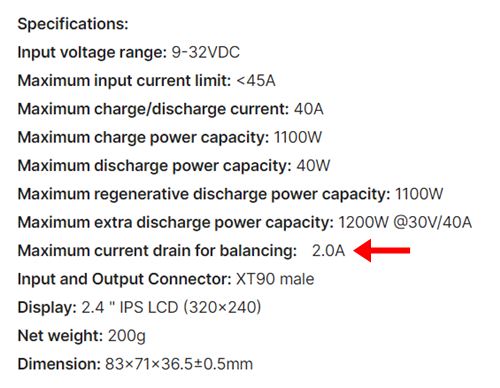
RC Battery Charger Power Supplies
As I mentioned, this one gets lots of email time, and in fact many folks are pretty upset when they get any computerized RC battery charger to find out it doesn’t come with any way to power it!
The same question keeps coming up all the time...
"Why don't these chargers come with a built in power supply?"
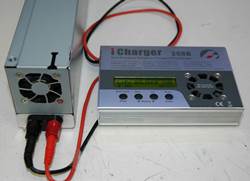
With more powerful RC chargers, having a separate PS makes the most sense for several reasons:
1. Size, weight & cost are the main ones. Pair a powerful 500W to 2000W charger with a 500-2000W 24-50VDC power supply and you would be looking at many hundred dollars not to mention something the size & weight of a cinder bock.
2. It allows the individual to purchase the PS based on their specific needs (current, voltage, Watts, input voltage, chargers they already have and budget).
3. It allows you to use your existing PS/s with new charger/s - again saving money.
4. It allows easy field charging with no bulky & heavy built in supply by way of a 12 or 24VDC vehicle power source.
5. If either the PS or Charger fail, you would be hooped with a costly combination unit, having to send the entire works out for repair or replacement when only one component is faulty.
There are certainly some computerized chargers on the market that
have the ability to support both a 12 VDC or higher input and household 120 AC
using a built in power supply. The problem with all these “built in
power supplies” is they offer very low power and only work with lower
power chargers up to about 200 Watts or so.
The reason the output is limited comes down to size... To pump out 200 Watts or more at 12 VDC and higher, the power supplies get large; much larger than the chargers in fact; not to mention the heat that large power supplies generate that would cook the charger without adequate cooling fans and heat sinks that would make them even bigger.
Depending on the RC battery charger you get, will dictate the power supply you need.
For example if you were to get a 250 Watt charger, you would need a power supply rated at about 20 amps @ 14 volts output (20 amps x 14 volts = 280 Watts). Remember, no charger will run at 100% efficiency, there are always losses so if the charger is rated at 90% efficiency for example, that 280 Watt number comes in at about 252 watts at 90%.
These are very basic calculations and things like how the power
supply is rated and the output voltage all come into play, but this
should give you a good starting point when choosing a power supply. If
your power supply is under rated, a good computerized RC battery charger
will simply limit the amount of charge current it is able to deliver. It won’t ruin the charger, but it could perhaps overheat the power
supply.
Most power supplies these days, even the fairly cheap ones will have over current and over heat protection so it is generally not an issue, you just wouldn't be able to charge at the maximum charge rate your charger is rated at.
Getting The Full Power From Any RC Charger - Pay Attention To Input Voltage!
One last important word on RC charger power supplies. In order to get the maximum power (current and voltage) out of your RC charger, you have to feed it the maximum input voltage it's also rated for.
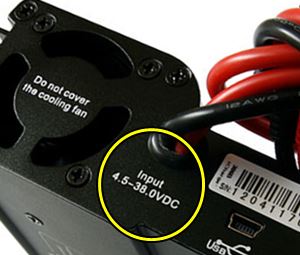 RC Chargers Usually Have A Fairly Broad Input Voltage Range.
RC Chargers Usually Have A Fairly Broad Input Voltage Range.Most RC Chargers will accept a broad DC input voltage range.
As can be seen in this picture, this iCharger will accept from 4.5 to 38.0 VDC.
I get this question so often when people are charging their batteries (specifically higher voltage ones); "my charger is not allowing me to charge at the higher current rates it's rated for."
Almost always, when I ask the question "what voltage are you feeding your charger", the answer is a voltage that is substantially lower than what the maximum rated input voltage of the charger is.
A very common one is trying to charge a 6S LiPo (25.2V fully charged), while using a power supply that is outputting 12VDC.
I think you can already recognize the limitation here. You can't get something for free, and when the charger's DC-DC boost converter circuit has to essentially double the input voltage up to the voltage the battery is being charged at, the maximum output current is halved. Fundamental Ohms law.
The charger will certainly still work at the low end of its input voltage range thanks to the DC-DC boost circuit; but if the battery/s you are charging have a higher voltage than the input voltage, maximum charge current will be reduced accordingly.
What Features Should You Be Looking For In The Best RC Battery Chargers?
Many of the features to look for in a best RC battery charger I already covered on the LiPo Battery page, but here is a recap plus other important features:
- Quality & Price
- Cost per Watt Value.
- The charger will support all rechargeable battery types.
- Reverse polarity protection - protects the charger from letting out the magic smoke if you hook the battery up backwards.
- Powerful enough for your charging needs (now and down the road).
- Supports the highest cell count of pack you intend on using (now and down the road).
- Has built in balance circuitry.
- Balance voltage accuracy in the 10 - 20 mili-volt range (0.01 – 0.02 volts).
- Balance discharge current should be at least 500mA (1.0 Amp or higher if you fly with larger capacity batteries or para-charge).
- Shows all cell voltages when balancing.
- Can measure the Internal Resistance of each cell.
- Back-Lit LCD display is nice and easy to read.
- Data logging and PC download/firmware update ability is a nice feature, but not absolutely necessary for most people.
- Safety features such as over/under voltage protection, time out feature, temperature probe for over heat protection, cell count confirmation/protection.
- Useful Lithium battery charging programs such as balance and storage charge.
- Useful NiCad/NiMH charging programs such as cycle charge/discharge, auto charge, programmable delta peak voltage settings, & forming charge.
- Battery memory programming of battery profiles so you don’t have to always set charge current and cell counts for your main batteries that you are charging.
NO mention of BUMP, BattGO or Spektrum SMART technology in that list you'll notice.
If you're not sure of what BUMP, BattGO or Spektrum SMART technology is? It's basically an RC charger that communicates electronically with special LiPo battery packs that have built in circuity to send battery specific information back to the charger. Yes, these are true "smart" chargers.
The idea is all you have to do is swipe the area of the battery that has the identification chip (tag) onto the charger's external or internal BUMP/Smart receiver/controller, or plug the BattGO battery into the charger with the special communicating power plug, and the charger automatically selects the correct charging/other settings for that specific battery.
Are we really becoming that lazy and dependent on microprocessors to do all the thinking for us?
Moreover, consider the drawbacks such as premium priced proprietary battery packs, lack of charging control, and forget about multi pack parallel charging. Sure, you can override to select all that manually, but then why spend the BUMP/BattGo/SMART premium in the first place if you are going to be manually overriding it all the time?
Again, this is just my opinion; but I really do see this as nothing more than a bunch of marketers sitting up into the wee hours of the morning, inventing something we don't need or even want; but trying to convince us we do. No doubt, it will appeal to some newbies who don't want to learn about all this cool RC charging stuff.
Smart battery rant over with, back to what to look for in the best RC charger for you.
Best RC Battery Charger Cost Per Watt Value
This is a really simple calculation I use to determine the "working value" of any RC battery charger. If you divided the price of the charger into the number of Watts, you get the dollar per Watt value.
For example, a $150.00 dollar charger that has a maximum Wattage rating of 500 Watts, would therefor have a cost of $0.3 or 30 cents per Watt. ($150.00 / 500 Watts)
This is not the only value consideration number to go by naturally. You need to consider features and quality as well, but cost per Watt is one of the first things I look at when deciding between two or more chargers with similar specifications, features, and quality.
To help you out, in all the following charger recommendations, I will jot down the cost per Watt (CPW) number in red.
Best Computerized RC Battery Charger Recommendations
It goes without saying, all the chargers listed below support all common RC battery chemistry's such as NiCad, NiMh, PB, and of course all lithium types (LiPo, LiFe, LiIon).
These are a few recommendations based on features, price, and quality. They should give you a good idea of what's out there to help you choose the best RC battery charger for your own needs.
I feel one of the better value and quality RC battery chargers that you can easily find online is the SkyRC iMax B6AC V2.
It's a combination AC/DC charger meaning the power supply is built right into the charger so you can just plug it into any standard household AC outlet.
It can also be powered from a DC power source such as a vehicle battery for field/track charging.
At around $60.00 USD, the value is good.
Like most chargers with built in power supplies, it's low on power at only 6A & 50 Watts. This is not a charger for people who need more serious charging power in other words, but for newbies just starting out with smaller RC aircraft that don't have too many packs to charge, it makes for a nice first charger. ($1.20 per Watt)
If you are looking for a low cost, plug in the wall AC plus DC powered dual port RC charger, SkyRC also has an amazing little RC charger called the D200 Neo. ($0.70c per Watt)
Higher Power LiPo / RC Battery Chargers
Once past the realm of the lower power chargers, and you are getting into larger birds or multiple pack parallel charging, it's time to start looking at higher power options such as this amazing small yet powerful (1100 Watt) iCharger S6.
You may be surprised to find out most have considerably lower cost per Watt numbers and offer much better value in that respect, but remember, they don't come with any sort of built in power supply.
They are powered externally from an AC to DC power supply or a DC battery (such as a car battery or LiPo pack).
As I already mentioned, my personal top pick when it comes to computerized RC battery chargers goes to the iCharger line. Buddy RC in Columbus Ohio is where I have gotten all mine. These chargers offer both quality with lots of power, and are some of the best RC chargers for the money in my opinion.
iCharger chargers are robust, reliable, and accurate. Most everyone loves them! Their highest power one is the 4512 Duo rated at a whopping 2800 Watts!
The pricing for these chargers as I mentioned is outstanding.
Advanced features they offer include:
PC interface data logging, automatic variable speed cooling fan, internal resistance measurements, intelligent high current balance charging, and regenerative discharging, many dual port models, intuitive & easy to navigate menus to name just a few of my favorite features.
Here are the basic specifications for the full lineup, along with approximate costs and links to check them out yourself starting with the compact size S & X series.
- iCharger S6 ... Rated at 40 Amps, 1100 Watts, supports up to S6 LiPo, $130.00 USD (12 cents per Watt).
- iCharger X6 ... Rated at 30 Amps, 800 Watts, supports up to 6S LiPo, $110 USD (14 cents per Watt).
- iCharger X8 ... Rated at 30 Amps, 1100 Watts, supports up to 8S LiPo, $130 USD (12 cents per Watt).
- iCharger X12 ... Rated at 30 Amps, 1100 Watts, supports up to 12S LiPo, $180 USD (16 cents per Watt).
- iCharger DX8 ... Dual Port, Rated at 30 Amps per port, 1600 Watts, supports up to 8S LiPo, $250 USD (16 cents per Watt).
- iCharger DX12 ... Dual Port, Rated at 30 Amps per port, 1700 Watts, supports up to 12S Lipo, $300 (18 cents per Watt).
Below are iCharger's 4 Series Dual Port chargers. These are larger chargers than the compact S & D Series, due primarily to having a much larger heat sink and cooling capacity. These chargers are more robust and why I prefer them over the smaller S & D series, especially when I need serious charging power.
- iCharger 456 Duo ... Dual Port, Rated at 50 Amps per port or 70 Amps synchronous, 2200 Watts, Supports up to 6S LiPo, $330 USD (15 cents per Watt). If you only use up to 6S packs, the 406 Duo will save you a few bucks over the 8S capable 458 Duo or 10S capable 4010 Duo.
- iCharger 458 Duo ... Dual Port, Rated at 45 Amps per port or 70 Amps synchronous, 2200 Watts, Supports up to 8S LiPo, $350 USD (16 cents per Watt).
- iCharger 4010 Duo ... Dual Port, Rated at 40 Amps per port or 70 Amps synchronous, 2000 Watts, supports up to 10S LiPo, $370 USD (19 cents per Watt). I've got this monster and absolutely love it!
- iCharger 4512 Duo ... Dual Port, Rated at 45 Amps per port or 70 Amps synchronous, 2800 Watts, supports up to 12S Lipo, $420 USD (15 cents per Watt).
iSDT Chargers
Another popular RC charger brand is iSDT.
They have a nice assortment of fairly powerful yet compact chargers at very good pricing.
Many people (myself included) find them easier to use than iCharger for the simple reason they don't have as many features.
In short, iSDT chargers are generally the best RC charger choice if simplified operation & use are important to you. A good meat & potatoes computerized RC charger.
Quality and accuracy however are not up to the standards of iCharger in my opinion; not enough to rule them out however and they are most certainly worth consideration.
- iSDT Q6 Nano ... Rated at 8A, 200 Watts, supports up to 6S LiPo, $30.00 USD (15 cents per Watt)
- iSDT Q8 Max ... Rated at 30A, 1000 Watts, supports up to 8S LiPo, $90.00 USD (BEST VALUE @ 9 cents per Watt)
- iSDT D2 ... Rated at 12A (x2), 200 Watts, dual port, built in power supply, supports up to 6S LiPo, $140.00 (70 cents per Watt)
- iSDT P30 ... Rated at 30A (x2), 1500 Watts, dual port, supports up to 8S LiPo, $190.00 USD (13 cents per Watt)
Best RC Battery Charger Charge Cables
Regardless of what brand or model of computerized RC battery charger you choose, you are going to need a way to hook your batteries up to it.
This requires a charge cable (also called a charge harness) or a para-board if you choose to parallel charge.
One end plugs into your charger by way of a positive and negative 4mm banana/bullet plug. This is pretty universal, but some of the newer & smaller computerized RC chargers are using dedicated RC connectors such as XT60's or XT90's plugs.
The other end/s plugs into your battery. You can use universal charge cables like the one shown above with many different battery connector types, or you can get plug specific harnesses.
I generally make my own RC charge harnesses, but if you just want to purchase your charge cables; Buddy RC's selection of cables is unmatched. As is their para-board selection if you want to use a para-board instead of a harness.
Below is a video I made showing the basics of how to make your own parallel charge harness so you can get a better idea of the materials and skills involved. It's usually less expensive to just purchase a ready made cable from Buddy RC or other vendor unless you already have all the parts on hand. I build mine mostly because I find it a fun & enjoyable part of the hobby.
HAPPY CHARGING...
